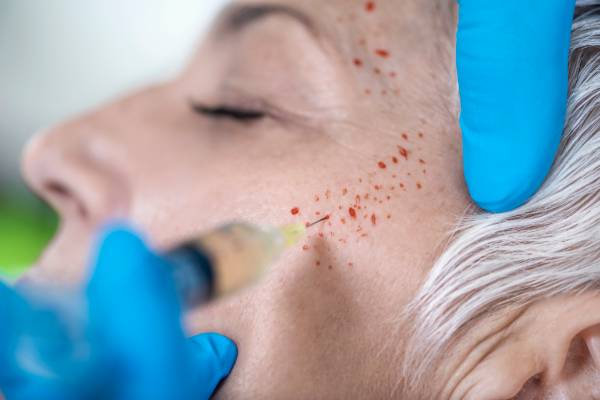Who Is a Candidate for PRP Treatment?

Platelet-rich plasma, or “PRP,” injections can promote healing from injuries, relieve arthritis, and encourage hair growth. The idea behind PRP treatment is that, where injected, the body will grow healthy cells and tissue. Dentists, doctors, surgeons, and dermatologists have used the substance since the 1970s.
What is PRP?
This process uses a blood sample from the patient to create the platelet-rich plasma. Using a centrifuge, the platelets are separated from the red and white blood cells, then concentrated in the plasma. The resulting PRP will be injected into or near the problem area.
When to use PRP
PRP has been used to treat various health issues and injuries, such as:
- Hair loss
- Osteoarthritis
- Acute injuries (e.g., sports injuries)
- Surgical wounds, including from oral surgery
- Tendon pain, such as tennis elbow and jumper’s knee
Some patients opt for PRP after having no success with steroid injections. Others may use it in the hopes of avoiding surgery.
How many injections will I need?
Depending on the issue, a patient may receive more than one injection. A local anesthetic may make the injection more comfortable for the patient. If the injection is used during surgery, this additional anesthetic is unnecessary.
The science behind PRP
The efficacy of PRP treatments is still being studied. There have been several clinical trials and many personal success stories. In fact, professional athletes have used PRP while recovering from sports injuries. However, the Food and Drug Administration has yet to approve PRP injections as a treatment.
Good candidates for PRP treatment
If a patient struggles to recover from surgery, acute injuries, or muscle injuries or lives with osteoarthritis, tendon pain, or chronic sprains or strains, they may be a good candidate for PRP. However, they should have already tried the first-line treatment for their health problem. In addition, they must be in good health overall.
PRP injections work in conjunction with other treatments. Getting PRP does not mean the patient will stop the traditional medical treatment. For example, it is common for patients to get injections after making slow progress in physical therapy. They will, however, continue therapy while getting PRP. Another common example is when an oral surgeon injects PRP near a surgical site to promote healing; the patient still needs routine postoperative care.
Who should not get PRP?
PRP treatment is not recommended for patients with the following medical conditions:
- Active infections
- Bleeding disorders
- Skin cancer
- Pregnancy
- Anemia
- HIV/AIDS
- Hepatitis C
Certain medications cannot be mixed with PRP, such as blood thinners.
Side effects of PRP
PRP injections can become infected if administered without proper sterilization. Pain at the injection site is common, like with any shot. However, it is also possible for the treatment to cause bleeding, nerve injuries, or tissue damage.
Learn more about PRP treatments
Current research suggests that PRP treatment could improve certain medical conditions. From sports injuries to osteoarthritis, patients have seen improvements where first-line treatments were ineffective. To learn more, ask a doctor if PRP is right for you.
Request an appointment here: https://www.restowell.com or call Restoration Wellness at (937) 661-6060 for an appointment in our Hillsboro office.
Check out what others are saying about our services on Yelp: PRP Treatment in Hillsboro, OH.
Recent Posts
Wondering when joint pain treatment is necessary? According to Healthline, joint pain refers to discomfort, aches, and soreness in any of the body's joints. There are certain signs that warrant when treatment is necessary.There are many different things that can cause someone to experience joint pain, with rheumatoid diseases being one of the more common…
"I feel so much better now, so thank you and goodbye forever!" Almost every chiropractor has heard those words at some point, and they often have to encourage their patients to be, well, patient. People then respond in two ways. As soon as they feel better, some patients leave the chiropractor for the last time,…
Thinking sciatica pain treatment is in your near future? While sciatica can develop due to an injury, it often develops over a period of time. According to Spine Health, most people who experience sciatica typically get better within four to six weeks with non-surgical sciatica treatments.Considering undergoing sciatica pain treatment from a chiropractor? Chiropractors focus…
Regenerative medicine is the science of growing new human cells, tissues, and organs damaged by injury or disease. It is an emerging field that also has the potential to help people with chronic illnesses, such as diabetes and organ failure. Read on to learn about regenerative medicine and how you could benefit.Tissue engineering is a…


